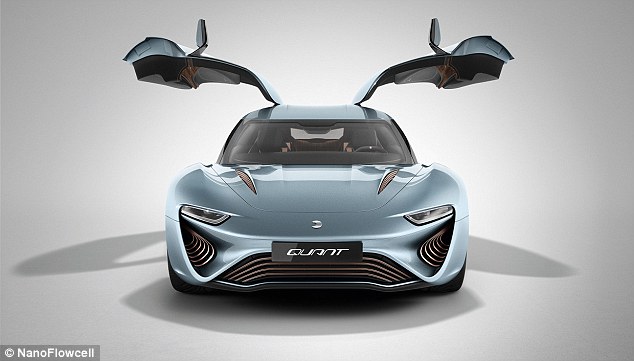The sports car that runs on SALTWATER:
Vehicle goes from 0 to 60mph in 2.8 seconds – and has just been approved for EU roads
- Quant e-Sportlimousine’s top speed is 217mph – equal to a McLaren P1
- The car uses a saltwater flow cell system to power four electric motors
- Water passes through membrane in tanks creating an electric charge
- Two 200-litre water tanks can provide a range of 373 miles (600km)
- The four-seater is 5.25 metres (0.4ft) long and 2.2 metres wide (7.2ft)
- Price and sale date yet to be confirmed, but may cost more than £1m
Sports cars may not have the best reputation for being environmentally-friendly, but this sleek machine has been designed to reach 217.5 mph (350 km/h) – using nothing but saltwater.
Its radical drive system allows the 5,070lbs (2,300kg) Quant e-Sportlimousine to reach 0-60 mph (100 km/h) in 2.8 seconds, making it as fast as the McLaren P1.
After making its debut at the 2014 Geneva Motor Show in March, the saltwater technology has now been certified for use on European roads.

It works in a similar way to a hydrogen fuel cell, however, the liquid used for storing energy is saltwater.
The liquid passes through a membrane in between the two tanks, creating an electric charge. This electricity is then stored and distributed by super capacitors.


After making its debut at the 2014 Geneva Motor Show (pictured) in March, the saltwater technology has now been certified for use on European roads.
The car carries the water in two 200-litre tanks, which in one sitting will allow drivers to travel up to 373 miles (600km)

No price or sale date has yet been revealed, but some experts suggest it could cost more than £1 million ($1.7 million)
NanoFlowcell AG, a Lichtenstein-based company behind the drive, is now planning to test the car on public roads in Germany and elsewhere in Europe as the company prepares for series production.
It claims the technology offers five times the energy capacity of lithium-ion batteries of the same weight.
‘We’ve got major plans, and not just within the automobile industry,’ says NanoFlowcell AG Chairman of the Board Professor Jens-Peter Ellermann.
‘The potential of the NanoFlowcell is much greater, especially in terms of domestic energy supplies as well as in maritime, rail and aviation technology.’






